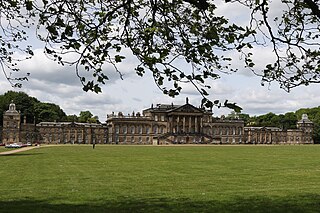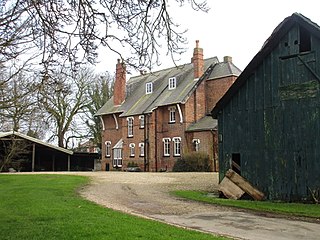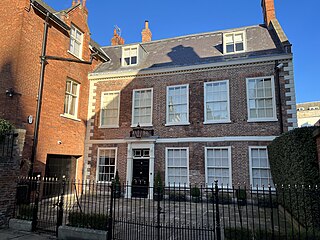
Gloucester Cathedral, formally the Cathedral Church of St Peter and the Holy and Indivisible Trinity, in Gloucester, England, stands in the north of the city near the River Severn. It originated with the establishment of a minster, Gloucester Abbey, dedicated to Saint Peter and founded by Osric, King of the Hwicce, in around 679. The subsequent history of the church is complex; Osric's foundation came under the control of the Benedictine Order at the beginning of the 11th century and in around 1058, Ealdred, Bishop of Worcester, established a new abbey "a little further from the place where it had stood". The abbey appears not to have been an initial success, by 1072, the number of attendant monks had reduced to two. The present building was begun by Abbott Serlo in about 1089, following a major fire the previous year.

Wentworth Woodhouse is a Grade I listed country house in the village of Wentworth, in the Metropolitan Borough of Rotherham in South Yorkshire, England. It is currently owned by the Wentworth Woodhouse Preservation Trust. The building has more than 300 rooms, with 250,000 square feet (23,000 m2) of floorspace, including 124,600 square feet (11,580 m2) of living area. It covers an area of more than 2.5 acres (1.0 ha), and is surrounded by a 180-acre (73 ha) park, and an estate of 15,000 acres (6,100 ha).

John Carr (1723–1807) was a prolific English architect, best known for Buxton Crescent in Derbyshire and Harewood House in West Yorkshire. Much of his work was in the Palladian style. In his day he was considered to be the leading architect in the north of England.

George Corson (1829–1910) was a Scottish architect active in Leeds, West Yorkshire, England.

The Old Holy Trinity Church is a redundant Anglican church in the village of Wentworth, South Yorkshire, England. It is partly in ruins, and stands close to a newer church also dedicated to the Holy Trinity. The old church is recorded in the National Heritage List for England as a designated Grade II* listed building, and is in the care of the Churches Conservation Trust.
There are over 20,000 Grade II* listed buildings in England. This page is a list of these buildings in the district of Craven in North Yorkshire.
There are over 20,000 Grade II* listed buildings in England. This page is a list of these buildings in the district of the City of York in North Yorkshire.
There are over 9,000 Grade I listed buildings in England. This page is a list of these buildings in the City of York in North Yorkshire.

Holy Trinity Church is a Grade II* listed parish church in the Church of England in Wentworth, South Yorkshire.

Bewholme Vicarage, in the village of Bewholme, East Riding of Yorkshire, England, is a former vicarage designed by the architect William Burges in 1859. It is a Grade II listed building and is now a private residence.

John Wormald Appleyard was a British sculptor and monumental mason based in Leeds, West Yorkshire, England.

Precentor's Court is an historic street in the English city of York. Although certainly in existence by 1313, the street does not appear on a map until 1610, and it is not given a name until 1722. It was given its current name exactly a century later.

Fenton House is an historic building in the English city of York, North Yorkshire. It is a Grade II* listed structure, standing at 9 Precentor's Court.

The York Arms is an historic building in the English city of York, North Yorkshire. It was designed by James Pigott Pritchett. Part of a seven-unit row that is a Grade II listed structure dating to 1838, it faces south at 26 High Petergate. These units are sandwiched between early-18th-century properties. The rear of the properties to the north, on Precentor's Court, are also part of the listing. They were originally residences for canons of the adjacent York Minster.

5 Precentor's Court is an historic building in the English city of York, North Yorkshire. A Grade II* listed structure, standing on Precentor's Court, the building dates to the early 18th century.

6 and 7 Precentor's Court are an historic pair of buildings in the English city of York, North Yorkshire. Grade II listed structures, standing on Precentor's Court, the buildings date to the mid-19th century, with number 7 having earlier origins. The properties were renovated in the 20th century.

10 Precentor's Court is an historic building in the English city of York, North Yorkshire.

Purey-Cust Lodge is an historic building in the English city of York, North Yorkshire. Now Grade II listed, it dates to 1845. Prior to this date, it was the stone yard for York Minster.

Purey-Cust Lodge boundary wall is an historic structure in the English city of York, North Yorkshire. A Grade II listed building, it dates to 1845.

St Trinity House is an historic series of four buildings in the English city of York, North Yorkshire. Grade II listed and forming the southern end of King's Square, parts of the structures date to the early 18th century, with alterations occurring over the next two hundred years. Their addresses today range from 3 to 4A King's Square. The Duke of York pub is at numbers 3 and 4; and the current use of 4A, the oldest building in the range, is not known. The only rendered front of the four, it adjoins 1 The Shambles to form an L-shape at the southwestern corner of the square. In the early 20th century, both buildings were the home of G. Ackroyd Furniture Stores.



















